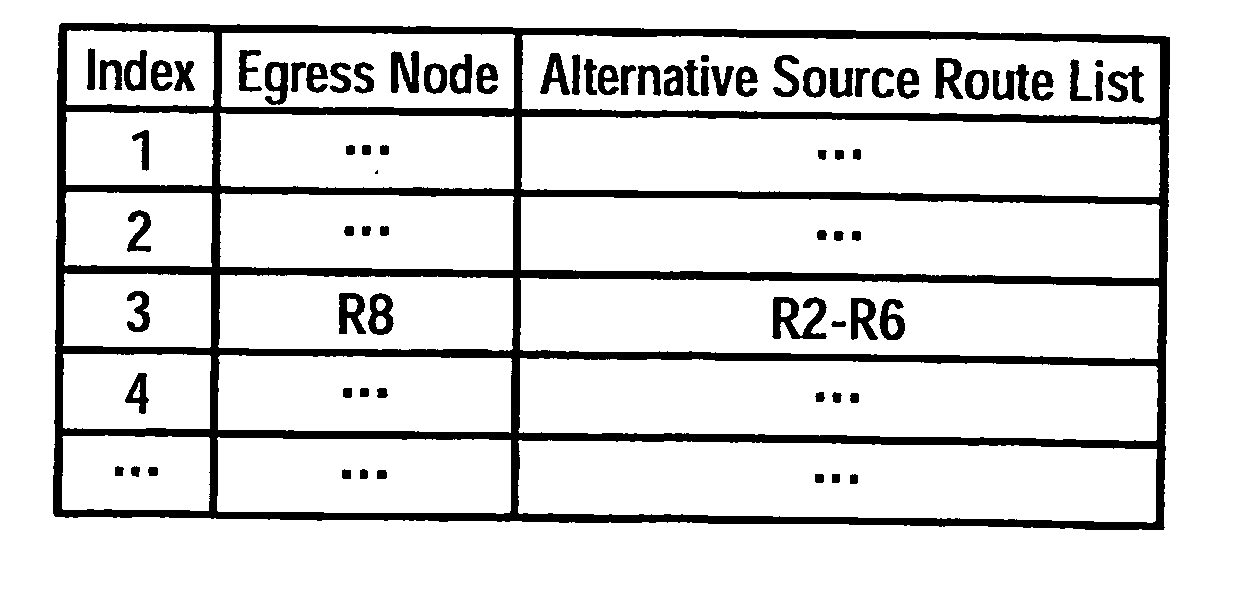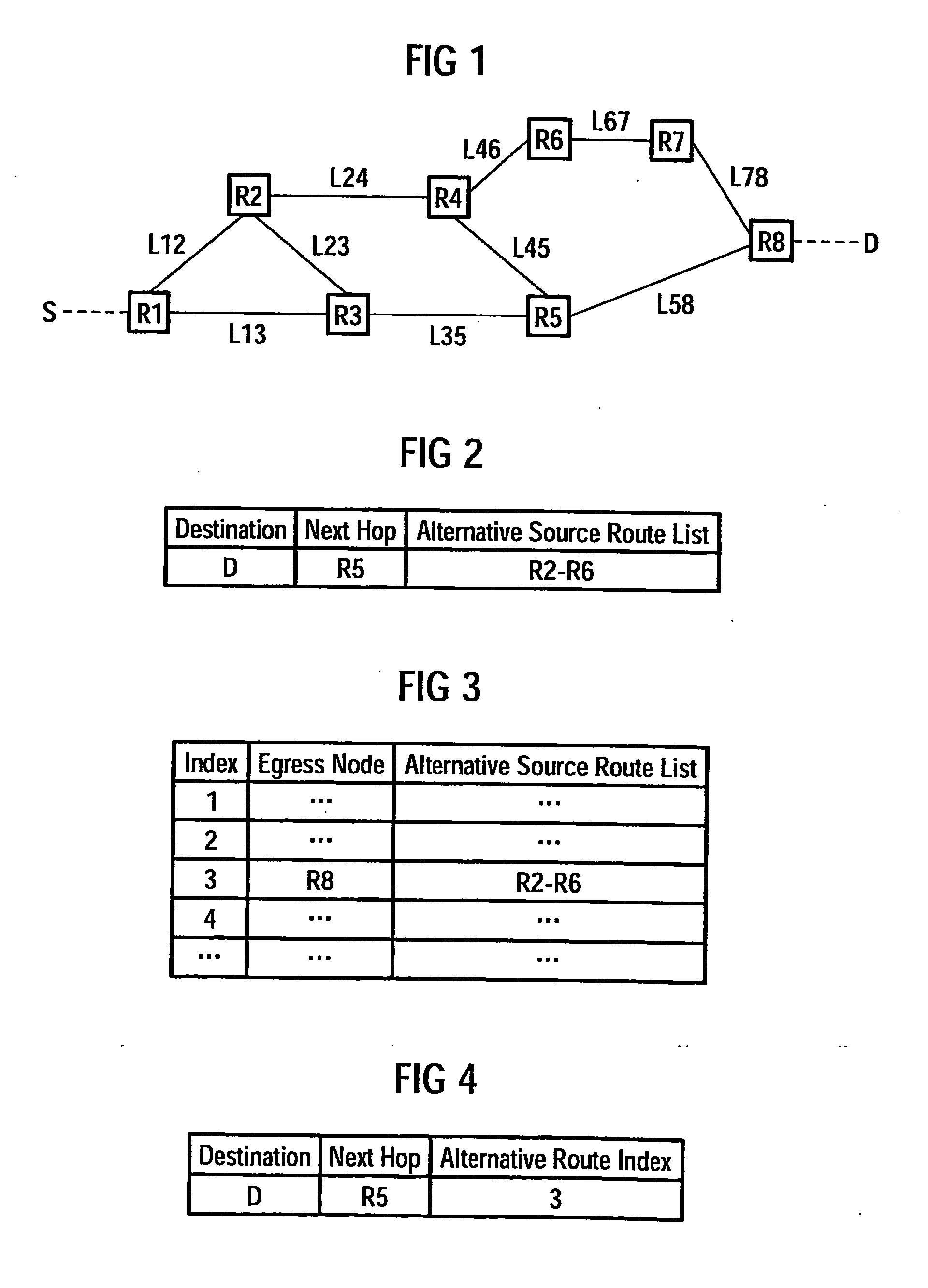[0012] The
advantage of the invention lies in permitting a fast response to malfunctions. Convergence as regards the
topology information propagated in the network ceases to be decisive for problem-free transmission of data packets within the network. It will be of practical
advantage to limit the length of time for applying the method according to the invention in accordance with the convergence of the
topology information within the packet network. The faulty node(s) will have been removed from the routing tables of the network nodes on restoration of convergence so that the response, according to the invention, of the network to malfunctions can be deactivated. The method is flexible in terms of the network's response to faults. As an instance of this, it will be possible to respond to the non-
accessibility of one or more nodes and even to the outage or, as the case may be, non-
accessibility of entire network sectors. The method according to the invention is not restricted to specific protocols. Present-day packet networks as a rule provide for a structure that distinguishes between routing within what are termed domains or, as the case may be, autonomous systems and routing between the various domains or, as the case may be, autonomous systems. The relevant
technical literature employs the terms “intradomain routing” and “interdomain routing” in this connection. The invention can be applied in connection both with any intradomain routing protocols such as, for example, OSPF (
Open Shortest Path First), IS-IS (Intermediate
System to Intermediate
System), NLSP (NetWare Link
Service Protocol), and PNNI (
Private Network-to-
Network Interface) for Link State Routing or RIP (
Routing Information Protocol), and RTMP (
Routing Table Maintenance Protocol) for Distance Vector Routing, and with interdomain routing, for example in conjunction with the EGP (Exterior Gateway Protocol) or BGT (
Border Gateway Protocol) protocol (EGP is used also as a generic term for interdomain protocols).
[0013] The process of calculating or, as the case may be, determining routing information for the outage of one or more network nodes can be triggered for example at the network node through notification of the outage or, as the case may be, malfunction. Routing information for avoiding non-accessible network nodes can alternatively be calculated in advance and made available in routing tables of the network node. For example, the network node has a
routing table which, besides a next hop for forwarding a data packet to a destination specified in the packet header of the data packet, contains a further entry with routing information or, as the case may be, routing addresses. If the next hop is not accessible, the routing addresses of the further entry in the
routing table will be inserted into the packet header of the data packet and routing based on said inserted addresses will then avoid the faulty node. The routing information for circumventing non-accessible next hops will not then have to be calculated when the malfunction is reported. The entries in the routing tables can be determined using a
list according to the invention of routing information or immediately after the routing tables have been produced. The calculating or, as the case may be, determining process can take place in the network node itself or at a central location or, as the case may be, in a central control node. If the calculating process takes place at a central location it is necessary for the calculation information to be propagated with the aid of a protocol to the relevant network nodes. This
disadvantage of additional traffic is countered by the
advantage of less computing overhead and reduced resource requirements in the network nodes.
[0014] An advantageous development in determining routing information for the purpose of routing via a path that avoids a non-accessible node is the complementary application of the
insertion according to the invention of routing information into the packet header and forwarding of the unchanged data packet to an alternative next hop. If it is ascertained while the routing information for routing according to the invention is being determined that forwarding from the network node to another next hop will suffice to avoid routing via the faulty network node, then it will not be necessary to insert the routing information into the packet header. For example, alongside a
list of routing information according to the invention, routing to an alternative next hop can, without modifying the packet header, be provided in a
routing table by means of a further entry indicating the applicable treatment in the event of malfunctions, if that will suffice to avoid the faulty network node.
[0015] The following is a further development covering a special case: The list of routing information can be determined by calculating an alternative path to the destination, which path avoids the faulty nodes. In special cases it is not possible to calculate an alternative path of this type. As an instance of this, an intradomain
routing protocol can provide, on the basis of the existing non-converged
topology information, for all
data traffic to a specific destination address to exit the network or, as the case may be, domain via the same fixed boundary node. In the event of an outage of said fixed boundary node, it will not be possible to calculate an alternative path to the data packet's destination on the basis of the existing topology information if convergence of the topology information within the network has not occurred following the boundary node outage. A provision according to the development is in this case to dispense with determining an alternative path and instead to determine a path in accordance with the boundary node outage applying the proviso that it will avoid the faulty node. For example, routing would then, based on the routing information or, as the case may be, list of routing information according to the invention, provide for forwarding of the data packet to a network node that has not failed. If the node is a boundary node, the data packet can then be forwarded to the destination (located in a different network) using an interdomain protocol. Following convergence of the topology information, a failed boundary node would then, of course, no longer be provided for routing to a destination outside the network and the method according to the invention would no longer need to be applied.
[0016] A provision of another advantageous development is for network nodes coming after the first network node to extract the routing information or, as the case may be, list of routing information in order to use it for routing data packets having the same destination but a different origin address. The network node coming after will be prompted, for example by the routing information inserted into the packet header, to forward the data packet to a next hop different from that provided for in the locally existing routing table. From the viewpoint of the network node coming after, there is a fault for which countermeasures have been taken to the effect that the data packet having the modified packet header is being forwarded to another next hop. Consequently, data packets having the same destination (which is to say that, as a rule, the destination address is in the same network or that the destination network is the same) must be forwarded in a manner different from that provided for in the local routing table, as must also the data packet modified in the packet header, in order to avoid the non-accessible node. The node coming after can use the routing information extracted from the packet header for routing data packets having the same destination. In the case of data packets that have the same destination and which have not already been modified for the purpose of avoiding the faulty node, the extracted routing information or, as the case may be, a part thereof affecting nodes coming after is, where applicable, inserted into the packet header in order to implement routing aimed at avoiding the non-accessible node. The node coming after is thereby spared having to calculate an alternative path from topology information for data packets having the same destination.
[0017] A further special case provides as part of the fault-avoiding process for a data packet to be sent back over the link via which it reached the network nodes. There are routing methods which, as part of the process of avoiding loops or delays, for instance, do not allow data packets to be sent back. According to the invention it can be provided for the restraint on sending back to be lifted in such a case.
 Login to View More
Login to View More  Login to View More
Login to View More 

